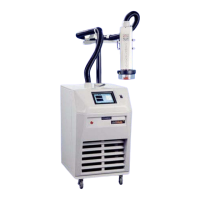. . . . .
PREPARATION FOR USE
Non-Standard Thermocouples
TP04300 Series Interface & Applications Manual 2-41
Non-Standard Thermocouples
Introduction Proper thermocouple to DUT contact is essential to insure accurate temperature sensing.
If the techniques given above (how to use the factory supplied socket/fixture(s) to attach Type
T, Type K, RTD/Diode sensors) are considered "standard" thermocouple and "standard"
sensor to DUT attaching techniques, then below are offered "non-standard" or "alternate"
techniques: first, how to construct a thermocouple; second, how to attach it.
Note: to enable testing, a socket/fixture must still be used, to apply power to the DUT circuits.
To properly construct a Type T thermocouple:
1. Use a small gauge (#26, #28, #30, or #36 gauge) teflon or kapton coated copper-constan-
tan thermocouple wire.
2. Using wire thicker than #36 gauge (0.005 inch / 0.013 mm) will conduct excessive heat
between the test specimen DUT and the ambient, resulting in inaccurate temperature mea-
surements.
3. Make the thermocouple junction as small as possible.
To properly attach a thermocouple, using alternate techniques:
1. Review the Sensor Interface Guidelines, page 2-33.
2. Follow the table and illustration below.
Alternate
Techniques
to Attach
Thermocouples
Alternate Techniques to Attach Thermocouples
SOLDERED ATTACHMENT
A UNSATISFACTORY: Sensor only contacts solder; no direct sensor to DUT
contact
B BETTER: Sensor directly contacts DUT, but sensor wire is exposed to ambient air
C BEST: Both sensor junction and sensor wire directly contact DUT;
sensor wire to DUT contact should be at least 30 times diameter of sensor wire
UNSOLDERED ATTACHMENT
1 THIN COPPER PLATE: attached to DUT with thin film of thermal grease
2 ADHESIVE BACKED: sensor "sticks on" to DUT with adhesive

